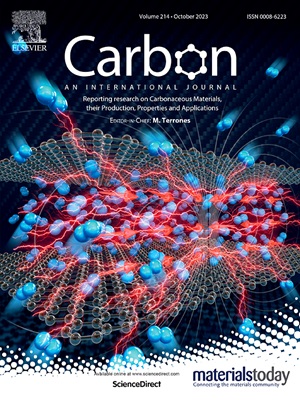Density regulation of surface hydroxyl on porous carbons as efficient catalytic supports
IF 10.5
2区 材料科学
Q1 CHEMISTRY, PHYSICAL
引用次数: 0
Abstract
Oxygen-containing functional groups play a crucial role in anchoring active metals on supported catalysts, especially hydroxyl groups, which hold advantages in regulating the electronic structure and optimizing the dispersion of metal species through their lone electron pairs. However, the coexistence of various oxygen-containing groups (e.g., C![]() O, C–O–C, C–OH) on carbon support is intractable in identifying the role of hydroxyl groups and revealing structure-activity relationships in the construction of effective supported catalysts. Herein, we established a regulation method for enriching hydroxyl groups of porous carbons by selective removal of ether oxygen-containing species via Diels-Alder (DA) reaction. This results in an increase in the proportion of hydroxyl from 30 % up to 54 %. The high proportion of hydroxyl on the obtained sample ET(200)-Air-HCM serves as an effective site for anchoring Pd species, thus leading to high dispersion of Pd nanoparticles featuring Pd2+ with an electron-deficient state. The highly dispersed Pd2+ species provides abundant active sites for the selective oxidation of benzyl alcohol with 99.7 % conversion and 99.6 % selectivity of benzaldehyde attained over Pd@ET(200)-Air-HCM at 363 K and 1 atm oxygen atmosphere. This study offers a facile method for the selective regulation of the proportion of hydroxyl groups on porous carbon-based materials for catalysis applications.
O, C–O–C, C–OH) on carbon support is intractable in identifying the role of hydroxyl groups and revealing structure-activity relationships in the construction of effective supported catalysts. Herein, we established a regulation method for enriching hydroxyl groups of porous carbons by selective removal of ether oxygen-containing species via Diels-Alder (DA) reaction. This results in an increase in the proportion of hydroxyl from 30 % up to 54 %. The high proportion of hydroxyl on the obtained sample ET(200)-Air-HCM serves as an effective site for anchoring Pd species, thus leading to high dispersion of Pd nanoparticles featuring Pd2+ with an electron-deficient state. The highly dispersed Pd2+ species provides abundant active sites for the selective oxidation of benzyl alcohol with 99.7 % conversion and 99.6 % selectivity of benzaldehyde attained over Pd@ET(200)-Air-HCM at 363 K and 1 atm oxygen atmosphere. This study offers a facile method for the selective regulation of the proportion of hydroxyl groups on porous carbon-based materials for catalysis applications.
多孔碳表面羟基作为高效催化载体的密度调节
含氧官能团在负载型催化剂上锚定活性金属方面起着至关重要的作用,特别是羟基,它通过其孤电子对调节电子结构和优化金属物种的分散具有优势。然而,各种含氧基团(如CO、C-O-C、C-OH)在碳载体上共存,在确定羟基的作用和揭示构建有效负载催化剂的构效关系方面是棘手的。本文建立了一种通过Diels-Alder (DA)反应选择性去除醚类含氧物质来富集多孔碳羟基的调控方法。这导致羟基的比例从30%增加到54%。所获得的ET(200)-Air-HCM样品上的高比例羟基作为锚定Pd物质的有效位点,从而导致具有缺电子态Pd2+的Pd纳米粒子的高分散。高度分散的Pd2+为苯甲醇的选择性氧化提供了丰富的活性位点,在Pd@ET(200)-Air-HCM上,在363 K和1 atm氧气气氛下,苯甲醛的转化率达到99.7%,选择性达到99.6%。本研究为多孔碳基材料的催化应用提供了一种选择性调节羟基比例的简便方法。
本文章由计算机程序翻译,如有差异,请以英文原文为准。
求助全文
约1分钟内获得全文
求助全文
来源期刊

Carbon
工程技术-材料科学:综合
CiteScore
20.80
自引率
7.30%
发文量
0
审稿时长
23 days
期刊介绍:
The journal Carbon is an international multidisciplinary forum for communicating scientific advances in the field of carbon materials. It reports new findings related to the formation, structure, properties, behaviors, and technological applications of carbons. Carbons are a broad class of ordered or disordered solid phases composed primarily of elemental carbon, including but not limited to carbon black, carbon fibers and filaments, carbon nanotubes, diamond and diamond-like carbon, fullerenes, glassy carbon, graphite, graphene, graphene-oxide, porous carbons, pyrolytic carbon, and other sp2 and non-sp2 hybridized carbon systems. Carbon is the companion title to the open access journal Carbon Trends. Relevant application areas for carbon materials include biology and medicine, catalysis, electronic, optoelectronic, spintronic, high-frequency, and photonic devices, energy storage and conversion systems, environmental applications and water treatment, smart materials and systems, and structural and thermal applications.
 求助内容:
求助内容: 应助结果提醒方式:
应助结果提醒方式:


